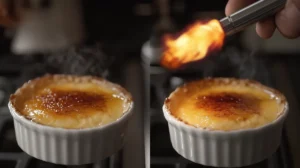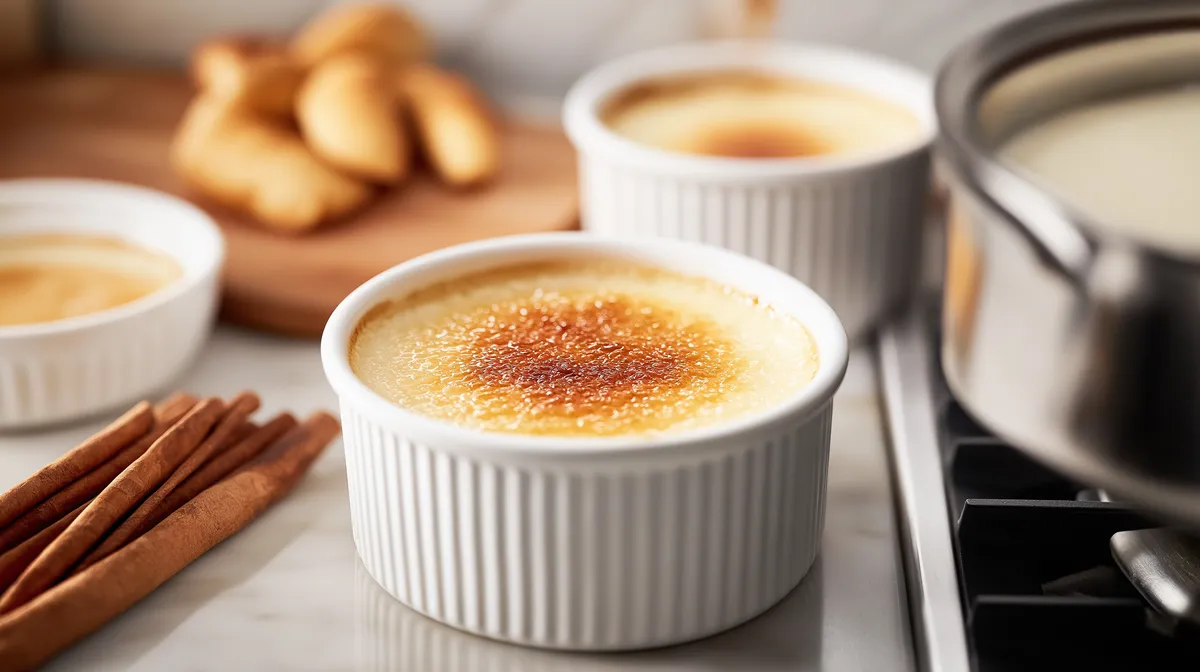Introduction
Crème Brûlée is a timeless dessert, beloved for its creamy custard base and the satisfying crack of caramelized sugar on top. Learning how to caramelize sugar on Crème Brûlée is essential to mastering this classic treat, as the sugar crust is what gives the dessert its unique charm. Whether you’re a seasoned chef or trying your hand at Crème Brûlée for the first time, understanding the process of caramelizing sugar will ensure your dessert stands out.
In this article, we’ll explore how to caramelize sugar on Crème Brûlée, covering the tools you’ll need, the steps to follow, and tips to achieve the perfect golden-brown crust every time. By the end, you’ll be well-equipped to impress your guests or enjoy a restaurant-quality dessert at home.
Table of Contents
| Sr# | Headings |
|---|---|
| 1 | Introduction |
| 2 | Why Caramelizing Sugar Is Essential for Crème Brûlée |
| 3 | Essential Tools for Caramelizing Sugar |
| 4 | Choosing the Right Sugar for Caramelization |
| 5 | Step-by-Step Guide to Caramelizing Sugar on Crème Brûlée |
| 6 | Tips for Perfecting the Caramelized Crust |
| 7 | Common Mistakes to Avoid |
| 8 | Alternative Caramelization Methods |
| 9 | Serving Crème Brûlée After Caramelizing |
| 10 | FAQs About Caramelizing Sugar on Crème Brûlée |
| 11 | Conclusion |
Why Caramelizing Sugar Is Essential for Crème Brûlée
Caramelizing sugar on Crème Brûlée is more than just a finishing touch—it’s the key to creating the dessert’s signature texture and flavor. The hardened sugar crust provides a delightful contrast to the smooth, creamy custard beneath it. The process of caramelizing sugar on Crème Brûlée involves heating sugar until it melts and turns golden brown, forming a brittle layer that cracks beautifully when tapped with a spoon.
This caramelized topping not only adds texture but also introduces a rich, toasty flavor that balances the dessert’s sweetness. Perfecting this process is essential for making a memorable Crème Brûlée.
Essential Tools for Caramelizing Sugar on Crème Brûlée
To master how to caramelize sugar on Crème Brûlée, you’ll need the right tools. Here’s what you’ll need:
1. Kitchen Torch for Caramelizing Sugar on Crème Brûlée
A kitchen torch is the most commonly used tool for caramelizing sugar on Crème Brûlée. It allows you to apply direct, controlled heat, ensuring even caramelization without overheating the custard beneath.
2. Fine Granulated Sugar
The type of sugar you use is crucial. Fine granulated sugar melts evenly, creating a smooth, consistent crust. Coarser sugars can lead to uneven caramelization.
3. Spoon or Sugar Shaker
A spoon or sugar shaker helps you distribute the sugar evenly across the custard’s surface. An even layer of sugar is essential for uniform caramelization on Crème Brûlée.
4. Protective Gloves
Wearing protective gloves can prevent burns and give you better control while using the kitchen torch, especially if you’re new to this technique.
5. Broiler (Optional)
If you don’t have a kitchen torch, you can use an oven broiler. This method requires careful monitoring to prevent burning but can still produce excellent results.
Choosing the Right Sugar for Caramelizing on Crème Brûlée
The type of sugar you choose plays a significant role in the process of caramelizing sugar on Crème Brûlée. Here’s how to select the best sugar for your Crème Brûlée:
1. Fine Granulated Sugar for Crème Brûlée
Fine granulated sugar is the preferred choice for caramelizing sugar on Crème Brûlée. It melts quickly and evenly, creating a smooth, golden crust that cracks perfectly under a spoon.
2. Superfine (Caster) Sugar
Superfine sugar, or caster sugar, is another excellent option. Its smaller crystals melt faster and more evenly than regular granulated sugar, making it ideal for achieving a flawless caramelized topping.
3. Brown Sugar (Optional)
Using brown sugar adds a deeper, more molasses-like flavor to the topping. However, it can be trickier to caramelize evenly due to its moisture content and may result in a slightly different texture.
4. Avoid Powdered Sugar
Powdered sugar is not recommended for Crème Brûlée. It contains cornstarch, which can interfere with caramelization and result in a gritty texture.
Step-by-Step Guide to Caramelizing Sugar on Crème Brûlée

Now that you have your tools and sugar ready, it’s time to learn how to caramelize sugar on Crème Brûlée. Follow these steps to achieve a perfect crust:
Step 1: Prepare the Custard for Caramelizing
Ensure your Crème Brûlée custard is fully set and thoroughly chilled before you begin caramelizing the sugar. This will help prevent the custard from melting under the heat.
Step 2: Evenly Sprinkle the Sugar
Using a spoon or sugar shaker, sprinkle a thin, even layer of fine granulated sugar over the surface of each custard. The sugar should just cover the custard, with no clumps or bare spots.
Step 3: Light the Torch
If you’re using a kitchen torch, ignite it according to the manufacturer’s instructions. Adjust the flame to medium-high, which provides enough heat to caramelize the sugar without burning it.
Step 4: Caramelize the Sugar on Crème Brûlée
Hold the torch about 2-3 inches above the surface of the sugar. Move the flame in a circular motion, gradually caramelizing the sugar. Watch carefully as the sugar melts, bubbles, and turns a golden brown. Avoid holding the flame in one spot for too long, as this can cause burning.
Step 5: Cool the Caramelized Sugar
After caramelizing the sugar, allow it to cool for a minute or two. This will harden the sugar, creating that signature crack when you tap it with a spoon.
Step 6: Serve Immediately
For the best experience, serve your Crème Brûlée immediately after caramelizing the sugar. The contrast between the warm, crunchy topping and the cool, creamy custard is what makes this dessert truly special.
Tips for Perfecting the Caramelized Crust on Crème Brûlée
To ensure your Crème Brûlée turns out perfectly every time, consider these additional tips:
1. Use a Fine Layer of Sugar
A thin, even layer of sugar is key to achieving a smooth, golden crust. Too much sugar can result in uneven melting and a burnt taste.
2. Keep the Torch Moving
Constantly move the torch in a circular motion while caramelizing the sugar on Crème Brûlée. This prevents the sugar from burning and ensures an even caramelization.
3. Test the Torch on a Small Area First
If you’re new to using a kitchen torch, start by caramelizing a small section of sugar to get a feel for the process before moving on to the entire surface.
4. Don’t Over-Caramelize
Remove the torch as soon as the sugar turns a golden brown. Over-caramelizing can lead to a bitter flavor and a burnt crust.
5. Serve Immediately After Caramelizing
The sugar crust is at its best right after it’s caramelized, providing a delightful contrast with the cool custard. For the best texture and flavor, serve Crème Brûlée immediately.
Common Mistakes to Avoid When Caramelizing Sugar on Crème Brûlée
Caramelizing sugar on Crème Brûlée can be challenging, especially if you’re not familiar with the technique. Here are some common mistakes to avoid:
1. Using Too Much Sugar
Applying a thick layer of sugar can cause uneven caramelization, with some areas burning before others have melted. Stick to a thin, even layer for the best results.
2. Holding the Torch Too Close
Holding the torch too close to the sugar can cause it to burn rather than caramelize. Keep the torch at a safe distance (about 2-3 inches) and move it continuously to prevent scorching.
3. Not Chilling the Custard Enough
If the custard isn’t adequately chilled before caramelizing, it can melt under the heat of the torch, leading to a soupy texture. Always ensure the custard is cold before adding the sugar.
4. Ignoring the Edges
Don’t forget to caramelize the edges of the custard. Many people focus only on the center, but a perfectly caramelized Crème Brûlée should have an even crust from edge to edge.
5. Over-Caramelizing the Sugar
It’s easy to overdo it and burn the sugar. Remember that caramelization can continue for a few seconds even after you remove the flame, so stop just as the sugar turns golden brown.
Alternative Caramelization Methods for Crème Brûlée
If you don’t have a kitchen torch, there are alternative methods to caramelize sugar on Crème Brûlée:
1. Broiler Method
Preheat your oven’s broiler to high. Place the sugar-topped Crème Brûlée under the broiler, positioning it close to the heat source. Watch closely and rotate the dishes as needed to ensure even caramelization. This method requires careful monitoring to avoid burning.
2. Hot Spoon Method
If you’re in a pinch, you can heat a metal spoon over a gas flame until it’s very hot, then press it against the sugar until it melts and caramelizes. This method is less precise and can be challenging, but it’s an option if you don’t have a torch or broiler.
3. Blowtorch (Hardware Store Variety)
A blowtorch from a hardware store can be used in place of a kitchen torch, provided it’s clean and safe for food use. This tool works similarly to a kitchen torch but may produce a larger, more powerful flame, so use it with caution.
Serving Crème Brûlée After Caramelizing the Sugar
Serving Crème Brûlée after caramelizing the sugar is all about timing and presentation. Here’s how to serve it for maximum impact:
1. Serve Immediately
Crème Brûlée is best served immediately after the sugar has hardened. The contrast between the warm sugar and the cold custard is what makes this dessert so delightful.
2. Add Garnishes
For an elegant touch, you can garnish your Crème Brûlée with fresh berries, a sprig of mint, or a dusting of powdered sugar. These additions enhance the visual appeal and add a pop of color.
3. Pair with Coffee or Dessert Wine
Crème Brûlée pairs beautifully with a cup of strong coffee or a glass of dessert wine, like Sauternes. The acidity and richness of these beverages complement the sweet, creamy dessert perfectly.
4. Present with Style
Serve your Crème Brûlée in the ramekins or dishes you used for baking. If you’ve used an alternative dish, make sure it’s attractive and adds to the overall presentation.
FAQs About Caramelizing Sugar on Crème Brûlée
1. Can I use brown sugar instead of white sugar?
While you can use brown sugar for a different flavor profile, it’s more challenging to caramelize evenly due to its moisture content. White granulated sugar is recommended for a smoother, more consistent crust.
2. What if I don’t have a kitchen torch?
If you don’t have a kitchen torch, you can use your oven’s broiler to caramelize the sugar. Just be sure to watch it closely to prevent burning.
3. How thick should the sugar layer be?
The sugar layer should be thin, just enough to cover the custard. A thick layer can lead to uneven melting and may result in burnt spots.
4. Can I caramelize the sugar in advance?
It’s best to caramelize the sugar just before serving. If done too far in advance, the sugar can absorb moisture from the custard, losing its crispness.
5. How do I know when the sugar is properly caramelized?
The sugar is properly caramelized when it turns a golden brown and has a smooth, glass-like finish. Be cautious not to let it turn too dark, as this can impart a bitter taste.
Conclusion
Caramelizing sugar on Crème Brûlée is a delicate process that requires the right tools, techniques, and a bit of practice. Whether you’re using a kitchen torch or an alternative method, the key is to achieve a smooth, golden crust that provides a satisfying contrast to the creamy custard beneath. By following the steps and tips outlined in this article, you’ll be well on your way to mastering this essential aspect of Crème Brûlée, ensuring a dessert that’s as visually stunning as it is delicious. Happy caramelizing!

